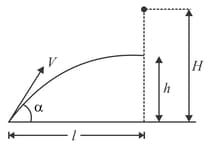A cannon fires successively two shells with velocity the first at the angle and the second at the angle to the horizontal, in the same vertical plane, neglecting the air drag, find the time interval (in ) between firings leading to the collision of the shells.

Important Questions on Kinematics
A small cannon is mounted on a platform (which can be rotated so that the cannon can aim at any point) and is adjusted for the maximum range of shells. It can throw shells at any point on the shown circle (dotted) on the ground. Suddenly a wind storm starts blowing in a horizontal direction normal to with a speed times the velocity of the shell. At what least distance can the shell land from point . (Assume that the velocity of the wind storm is imparted to the shell in addition to its velocity of projection. Also, assume that the platform is kept stationary while projecting the shell.)

A body falls freely from some altitude . At the moment the first body starts falling another body is thrown from the earth's surface, which collides with the first at an altitude . The horizontal distance of that point of collision is from the starting point of . Find the initial velocity and the angle at which it was thrown?

The time interval between the firings and
The coordinates of the point . Take the origin of the coordinate system at the foot of the hill right below the muzzle and trajectories in plane.
A small ball is thrown from the edge of one bank of a river of width to just reach the other bank. The ball was thrown in the vertical plane (which is also perpendicular to the banks) at an angle to the horizontal. Taking the starting point as the origin , vertically upward direction as positive -axis and the horizontal line passing through the point and perpendicular to the bank as -axis find
(a) equation of trajectory of the image formed by refraction by the water surface (water surface is at the level )
(b) The instantaneous velocity of the image formed due to refraction. .
